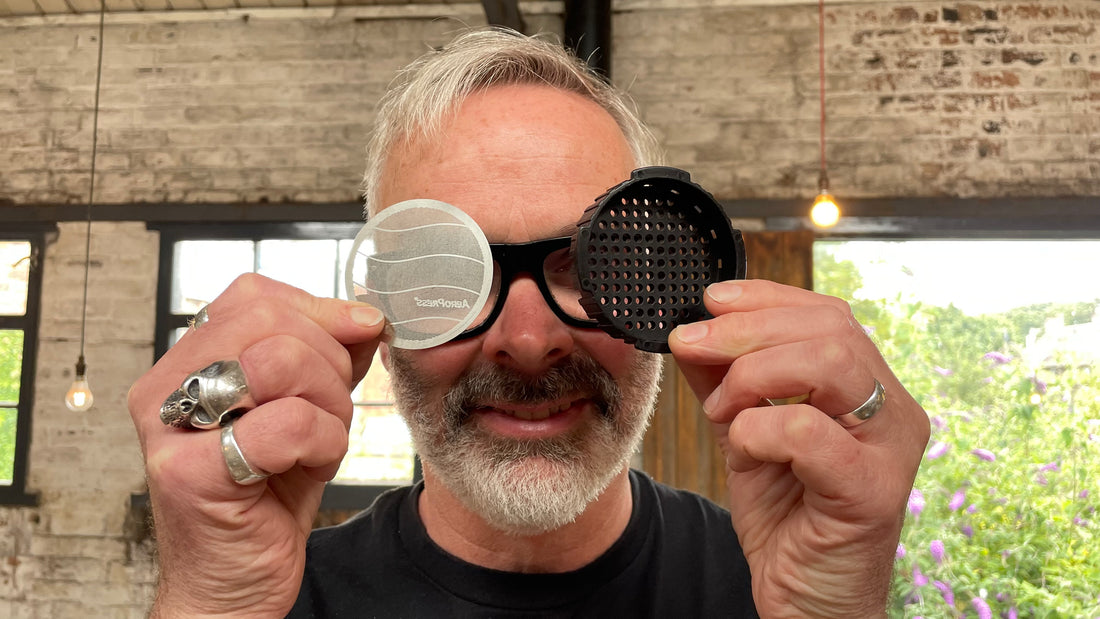By Mick Gormley
In recent weeks, visitors to Steampunk and readers of our newsletter will have seen our beautiful new tins, which have provided an elegant solution to our difficulties sourcing wholly recyclable packaging.
We are always looking to support anything that promotes sustainable ways of consuming coffee and I have been very keen to try the new metal filters recently introduced by the makers of the Aeropress.
If you haven't used an Aeropress, this brilliant, versatile brewing device has a chamber in which coffee grounds are steeped, and a piston which pushes the liquid coffee through a small paper filter into a cup. After the stovetop Moka Pot, it was my first introduction to making 'fancy' coffee at home.

Choosing a metal filter removes the need for the disposable, single-use paper filters, which is undoubtedly a great idea. While used filters can be composted, it's quite a messy, faffy business. I've even heard of well-intentioned coffee geeks trying to dry out and reuse paper filters (I used to do this with tea bags - always with miserable results - as a student in the 80s. Is that still a thing?)
However, there are a couple of points to be made about this... I was given my trusty Aeropress for Christmas back in 2015. I have made hundreds, possibly thousands of coffees with it, and to my best recollection have never had to fill up the neat little filter holder, which still has a tower of papers about 4 cm deep. It may be my iffy memory playing tricks on me but I've heard lots of people say the same thing, so I'm convinced there is some kind of weird physics going on there.
Secondly, and more importantly, using a metal filter produces a coffee that is wholly different to a drink made with a paper filter.
I'd enjoyed using other 'bootleg' metal Aeropress filters before, but when the 'official' version arrived at Steampunk I was still taken aback by how it changed the flavour profile of the Burundi beans I was brewing. How? What??!!
The Aeropress website has an informative blog post which outlines the benefits of metal vs paper, and offers a couple of recipes to help you get the best out of this shiny piece of kit. The main point is that paper filters block out flavourful oils present in the coffee beans, and reduce the rich texture that can result from allowing very fine grind particles into your coffee. Going Full Metal Filter gives you, if you're ready for them, potentially wonderful elements that are otherwise lost when you exercise restraint.
A bit of marketing speak creeps in when Aeropress claim that their metal filter 'adds another dimension of control to an already versatile coffee maker'. To be honest I think the opposite is true - it willingly throws control to the winds and makes a less refined coffee that is richer, fruitier, full of unexpected flavours and maybe even a little bit wild.
There is definitely a personal preference thing here - I like a beautifully clean and delicate drink as much as the next person, but I also love the bolder taste and denser feel that a coffee made with the metal filter gives you. For sure, that's not the case with everyone.
Over the past couple of weeks at Steampunk I have made dozens of Aeropress coffees, brewing with metal and paper filters side by side to better understand the differences, exploring our different coffee beans (from Peruvian to Rwandan and beyond) and canvassing opinion from colleagues on the results.
One thing I've discovered is that the recipes on the official Aeropress website don't really do justice to the metal filter. Their blog post proposes two alternatives: a longer drink, akin to a cafetiere-style coffee, and a shorter drink that mimics an espresso (but is actually closer to a long black).
My experience (after exhaustive testing) has been be that neither of these recipes work using the traditional 'upright' method that Aeropress recommends, and you can only get good results from the 'inverted' method, where the brewing chamber is positioned upside down and then flipped just before you push the plastic piston down. The reason for this is that the holes in the metal filter allow water to pass through the coffee grounds too quickly (it's actually more of a mesh than a disc with tiny holes).

In addition, I haven't really enjoyed the longer 'cafetiere' drink and think the real strength of the Aeropress metal filter lies in creating a pretty decent, home-brewed homage to espresso, that doesn't require an expensive machine.
The recipe below is adapted from a YouTube video produced in lockdown by every coffee nerd's patron saint, James Hoffman, to help everyone stuck at home replicate espresso-based drinks (in a loose-ish sense) when all the cafes were closed.
The Aeropress cannot make espresso, but it's enormous fun to try anyway, and this drink was a real revelation to me, hugely enjoyable in its own right rather than trying to pass itself off as something it isn't. It will definitely appeal to anyone who loves the full-bodied hit of espresso, and to my mind makes a kind of Long Black-ish drink that tastes a little less diluted, a little more ... whole.
It's also worth pointing out that I think the 'unofficial' Aeropress filters offer a very useful (probably even better!) alternative to the official ones, and we stock some made by a Glasgow-based company called Concetto. They too have an excellent video which suggests recipes for a shorter and longer drink, which are worth trying out (the video is terribly, terribly stylish but please don't be intimidated, as I was, of course). Incidentally, I found the Concetto metal filters a bit thicker and more robust than the official Aeropress ones, less prone to bending when removing from the brewer.
In the first instance I would recommend trying the Hoffman method (my daughter Zoe, with only a hint of amused cynicism, calls him the 'David Attenborough of coffee').

